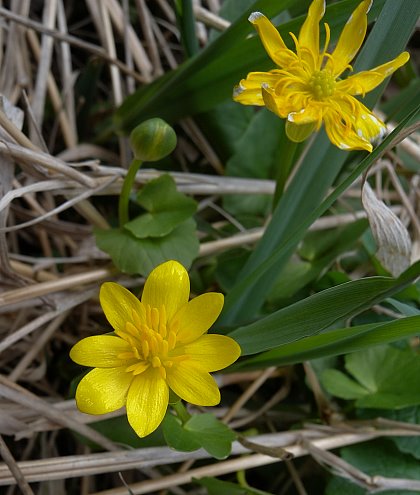
Flowers are produced individually from the axils of upper leaves, or they may terminate the upper stems. Each flower spans about 1" across, consisting of 7-12 yellow petals, 3 light green sepals, a ring of about 30 stamens, and a central cluster of about 15 pistils. The petals are elliptic or oblong in shape and only slightly overlap, while the sepals are ovate with blunt tips. The sepals are about two-thirds of the length of the petals. The pedicels of the flowers are 2-6" long, light green, terete, and glabrous. The blooming period occurs from early to mid-spring, lasting about 1 month. Afterwards, the flowers are replaced by seedheads spanning about 1/3" (8 mm.) across at maturity. Each seedhead has about 15 achenes. The achenes are ¼" (6 mm.) long and about one-half as much across; they are slightly flattened and beakless. The root system consists of a cluster of shallow tubers and fibrous roots. Clonal colonies of plants are often formed by clonal offsets from the tubers and by the spread of bulbils. The latter can be distributed by water.
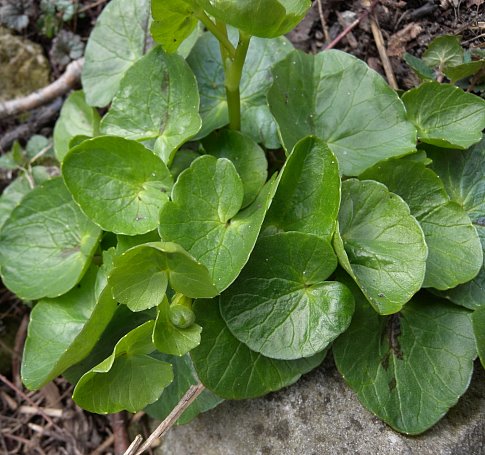
Cultivation: The preference is full sun to light shade, moist conditions, and soil containing loam, silt, or calcareous sand. However, Lesser Celandine can survive in moderate shade (where it may fail to flower) and drier conditions. Because the seeds are often infertile (especially for ssp. bulbifer), this species is more readily propagated by its bulbils or division of its tuberous roots. It should be noted, however, that Lesser Celandine can spread aggressively and it is considered an invasive species in many parts of North America.
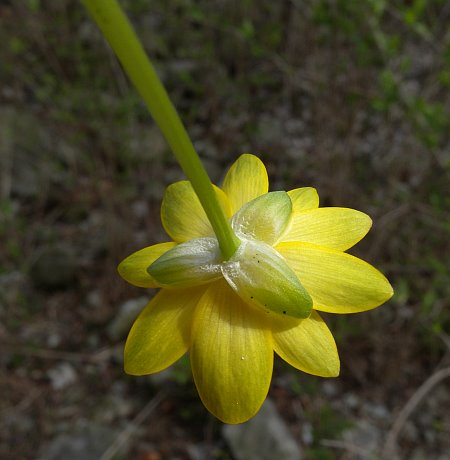
Range & Habitat: The non-native Lesser Celandine is apparently rare in Illinois, where naturalized plants have been observed in only two counties (see Distribution Map). In some northeastern states, it is more common and highly invasive. Unless vigorous methods are adopted to control its spread, it seems likely that Lesser Celandine will become more common in Illinois in the future. Lesser Celandine was introduced into North America from Eurasia as an ornamental and medicinal plant. Habitats consist of floodplain woodlands, grassy meadows, streambanks, roadside ditches, and moist waste areas. Both degraded and higher quality habitats can be invaded. Because of its ornamental flowers, Lesser Celandine is sometimes cultivated in gardens, although this practice has been made illegal in some northeastern states.
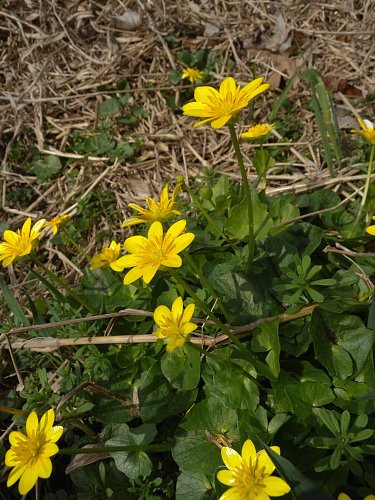
Faunal Associations: Little is known about floral-faunal relationships for this species in North America, although it is probably similar to other moisture-loving Ranunculus spp. (buttercups). The early-blooming flowers are cross-pollinated primarily by small bees, flies, and beetles. Both nectar and pollen are available as floral rewards to such visitors. Two leaf beetles are reported to feed on the foliage of buttercups: Prasocuris ovalis and Prasocuris vittata (Clark et al., 2004). The aphids Thecabius affinis and Thecabius gravicornis also suck on the sap of these plants during the summer (Cranshaw, 2004; Hottes & Frison, 1931). Among birds, the seeds and young foliage of buttercups are eaten to a minor extent by such gamebirds as the Wood Duck, Ruffed Grouse, Wild Turkey, and Ring-Necked Pheasant; the seeds are a minor source of food to such songbirds as the Mourning Dove and Snow Bunting. Among mammals, the young foliage is eaten to a limited extent by the Muskrat and Cottontail Rabbit, while the seeds are eaten by the Meadow Vole and Pine Mouse (Martin et al., 1951/1961; Lewis, 1993). Some turtles also reportedly feed on these plants (Lagler, 1943). The mature foliage, roots, and tubers of Lesser Celandine, however, are quite toxic because they contain a blistering agent that can irritate the gastrointestinal tract. If the foliage is dried out or subjected to heat, its toxicity is reduced or eliminated.
Photographic Location: A streambank at Meadowbrook Park in Urbana, Illinois.
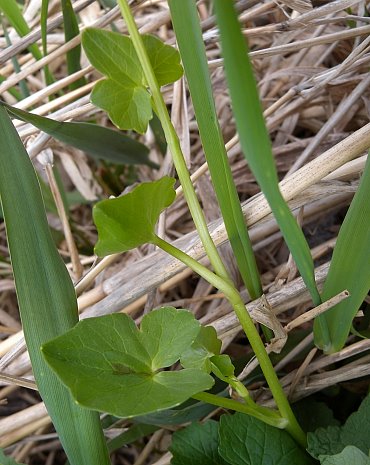
Comments: While Lesser Celandine has attractive foliage and flowers during the spring, it is also aggressive and invasive. It is easily confused with a native wildflower in Illinois, Caltha palustris (Marsh Marigold), because their leaves are similar in appearance and both species produce showy yellow flowers during the spring in moisture-abundant habitats. The flowers of these two wildflowers are readily distinguished: Lesser Celandine has 3 green sepals per flower, while Marsh Marigold has only yellow petaloid sepals and no true petals. In addition, the petals of Lesser Celandine are more narrow in shape than the corresponding petaloid sepals of Marsh Marigold. There are two subspecies of Lesser Celandine that can be recognized: the diploid Ranunculus ficaria ficaria and the tetraploid Ranunculus ficaria bulbifer. The typical subspecies has a more erect habit, usually lacks bulbils, and its seeds are more fertile, while the latter subspecies has a more sprawling habit, readily produces bulbils, and its seeds are rarely fertile. Sometimes Lesser Celandine is referred to by the scientific synonym, Ficaria verna. Another common name for this species is Fig Buttercup, where the 'fig' in this common name refers to the shape of the tuberous roots. Even though they share similar common names, Lesser Celandine and Greater Celandine (Chelidonium majus) are not closely related to each other. The latter species belongs to the Poppy family (Papaveraceae) and its flowers have only 4 petals.